Vince Darcangelo's Blog, page 11
March 20, 2014
Review: Kinder Than Solitude
Kinder Than Solitude
Yiyun Li
This is a book that will break your heart. From the uncomfortable opening scene at the 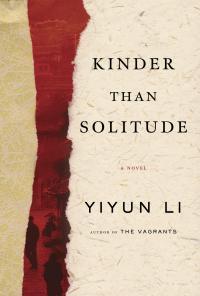 crematorium, across continents and decades, this is a longitudinal gut-punch of a novel dealing with loss, guilt, terror and fragility.
crematorium, across continents and decades, this is a longitudinal gut-punch of a novel dealing with loss, guilt, terror and fragility.
The person being burned to ashes in the beginning is Shaoai, a childhood friend of the three main characters who was poisoned (perhaps deliberately, perhaps not) in her youth. She has finally passed after two decades in a coma, and her death brings together our lead trio—Moran, Ruyu and Boyang.
From here, the journey turns inward.
Li pens exquisite prose, with beautifully crafted sentences as philosophical as they are proficient. If I have one critique it is that the language, however beautiful, can sometimes stand in the way of the storytelling. Li is able to meditate on moments, which can subsume the reader into the novel, but at times can also push them out.
This is literary mystery, so of course there’s more to it than solving the crime. This is as much about Shaoai’s poisoner as Sherman Alexie’s Indian Killer is about catching a serial killer. What matters isn’t revealing what happened, but exploring the intersection of the lives touched by Shaoai’s coma and death—inhabiting the grief and guilt harbored by the three survivors.
We all have childhood regrets, and we’ve all known someone who never made it to adulthood (though not necessarily linked the way they are here). There are things we would like to change. There are times we wonder why we’re still here and someone else isn’t.
How do we go on with this knowledge? Li doesn’t necessarily answer that question, but she gives us a disarming portrait of three childhood friends coming to terms with a past they can’t quite shake and a mystery that will both intertwine them and isolate them forever.


February 26, 2014
Review: Playing at the World
Playing at the World
Jon Peterson
Remember the first time you crawled a dungeon, slayed the dragon and stuffed as 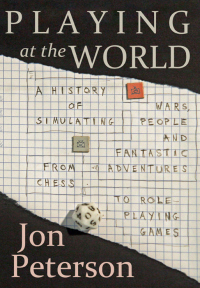 much treasure as you could into your “bag of holding”? Felt good, right? But the true prize wasn’t the booty. Sure, I enjoyed counting the gold and platinum coins, drooling over the prospects of upgraded armor, a magic-enhanced broad sword and whatever mischief I could scare up with a few copper pieces at the local tavern.
much treasure as you could into your “bag of holding”? Felt good, right? But the true prize wasn’t the booty. Sure, I enjoyed counting the gold and platinum coins, drooling over the prospects of upgraded armor, a magic-enhanced broad sword and whatever mischief I could scare up with a few copper pieces at the local tavern.
But what intrigued me most were the tattered spell scrolls, mysterious tomes and the secrets of the ancients.
It shouldn’t be much of a surprise. A rabid imagination is the primary tool that all fans of role-playing games bring to the table, and a trove of yellowed parchment and faded maps makes us froth at the mouth. Just how powerful is that fireball incantation? What wisdom could be discovered in that old paladin’s codex?
That’s what it feels like digging into Jon Peterson’s Playing at the World: A History of Simulating Wars, People and Fantastic Adventures, from Chess to Role-Playing Games. For any experienced gamer, this is a hoard worthy of any dungeon campaign.
It’s no longer groundbreaking to think of gaming as a topic for academic or cultural studies, but while many books have been written about gaming and gamers, they tend to be focused on a particular aspect of the genre, rather than presenting a comprehensive history. Peterson spent more than five years of archival research and writing creating Playing at the World, the definitive history of gaming and, by far, the most ambitious.
Though originally published in 2012, Peterson’s book has been reissued in honor of D&D’s 40th birthday. Four decades can offer a lot of history, but Peterson goes even further, tracing its lineage back to chess and existing war games.
By Peterson’s own admission, this book isn’t necessarily intended for a mainstream audience. It is a dense, detailed work of history and, if I dare say, sociology. It belongs on the book shelf (or e-reader) of any serious gamer, and though it may not be a front-to-back page-turner, it is an important resource for anyone who geeks out on geeking out.
The book’s most important contribution, though, has yet to be realized. In the decades to come, as gaming and gaming studies grow even bigger, Playing at the World will serve as both source material and historical lockbox upon which the future of gaming is framed and its past is preserved.


February 22, 2014
Review: The Winter People
The Winter People
Jennifer McMahon
What is it about New England that inspires isolated, small-town horror tales in which the 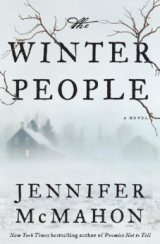 blood runs as cold as the weather? I’m not sure what it is exactly, but having spent many a wintry a night in Maine, I am familiar with that feeling.
blood runs as cold as the weather? I’m not sure what it is exactly, but having spent many a wintry a night in Maine, I am familiar with that feeling.
And I can’t get enough of it.
Jennifer McMahon captures that frostbite feeling perfectly in The Winter People, a heartbreaker of haunted legends and legacies, curses and karma, and, more than anything, unendurable loss.
The Winter People has a dual narrative—a modern-day mystery in which a teenager, Ruthie, is forced to take charge of her little sis when their mother goes missing. While searching for her mother, she stumbles upon the diary of Sara Harrison Shea, who lived in the house in 1908.
The diary does not have a happy ending. Both Sara and her daughter died in 1908, but the journal entries suggest that death is not exactly the end of the story.
The Winter People is well-written and bursting with heart. There are mysteries at every turn, and reminders that grief can be deadly. Or worse. In one of the book’s most haunting devices, Ruthie discovers that her mother has nailed shut her closet from the outside. For what purpose? Let your imagination go wild with that one.
The soul of the book, though, is the “sleepers.” Ruthie learns of a spell that will raise the dead for seven days’ duration, after which they are gone forever. It’s a universal temptation. Wouldn’t it be great to say a proper goodbye to a loved one who died suddenly? To hold a lover’s hand just a little longer? To actually say the things we think to say only after it’s too late?
Or would it be a daily torment, watching the minutes and hours crumble to dust?
But there is always a price. Like a modern retelling of “The Monkey’s Paw,” there are consequences for disrupting the dead, and The Winter People reminds that despair can drive even the most sensible among us to dangerous depths.
That’s what makes this novel so endearing. And so heartbreaking.


February 21, 2014
Review: The Ghost of the Mary Celeste
The Ghost of the Mary Celeste
Valerie Martin’s new novel, The Ghost of the Mary Celeste, is a bit like a star-studded variety show. It’s got a little bit of everything: maritime mystery, historical figures, [image error]supernatural subterfuge and… Sherlock Holmes?
The oddest part about the above description is that this book is more fact than fantasy.
Martin is a prize-winning master of historical fiction (Mary Reilly, Property), and this time around, she takes on the legendary ghost ship Mary Celeste, which was discovered abandoned, though still seaworthy, in 1872, her crew never to be seen again. This true-life mystery caught the attention of Martin, as well as another author (a young Arthur Conan Doyle published a fictionalized account of the ghost ship).
The terror is subtle in this novel. Martin makes use of found documents—journals, diaries, articles—to blend the factual with the fantastic. She meanders through time, takes on the social norms and issues of the day, and makes use of historical record real and imagined. She thrills us, certainly, but unfortunately leaves us with a tangled knot of loose ends.
There is no doubting the quality of the writing. Martin is a master storyteller, and her opening chapter is as harrowing as anything I’ve read this year. She places us in the heart of the Mary Celeste as it sails toward its destiny. Her words, like the storm, encroach, terrorize and ultimately consume, and after finishing the first chapter, I had to set the book aside for a while.
With equal skill, Martin details the lives of those left behind following the tragedy. There is heartbreak, romance and more tragedy on land. Every scene, every line of dialogue, every description is near perfect.
This is, however, a challenging book, not in content but in structure. I’m usually a fan of difficult reads—I take it as a sign of respect when an author, such as Martin, asks more of her readership than passive engagement. The narrative shifts through time, location and point of view. Indeed, there is a clever chronology, as the shipwreck segues to the survivor story segues to Doyle’s voyage segues to spiritualism. However, though they’re all linked by the Mary Celeste, the narratives feel more like vignettes. I found myself invested in each storyline, only to have it pulled out from under me with every new section. Nothing felt complete. As much as the writing drew me in, the shifting narrative pushed me away in equal measure.
This is just one reader’s opinion. Martin’s body of work speaks for itself. She is a gifted writer and storyteller, an astute chronicler of history with a great imagination. To any reader looking for a challenge, I say go for it. Get yourself a copy and enjoy the ride. For me, though, the novel is a bit like the Mary Celeste—seaworthy, but somehow I got lost along the way.


January 4, 2014
Final Thoughts, 2013
It’s a new year, and as much as we’re looking forward to the 2014 reading list, we have some 2013 shelf clearing left to do. Here is a round-up of books we enjoyed, but were so busy reading we didn’t have time to review.
The Undeserving Poor: America’s Enduring Confrontation with Poverty: Fully Updated and Revised
Michael B. Katz
It’s been a quarter-century since the first edition of this book was published. Some  things have changed drastically: The first edition came out at the height of the Reagan-Bush era, whereas the new edition comes on the heels of major Democratic victories in 2012.
things have changed drastically: The first edition came out at the height of the Reagan-Bush era, whereas the new edition comes on the heels of major Democratic victories in 2012.
But some things haven’t changed: The cultural obsession of equating financial poverty with moral bankruptcy.
Katz does a wonderful job of exploring the evolution of blame-the-poor politics and the invention (and ongoing reinvention) of the underclass. It’s a slippery and interesting social history, and it brings to mind Foucault’s histories of mental illness and prisons.
One of the interesting takeaways for me is the human need to compartmentalize. There is a line drawn between the deserving and the undeserving poor. Women and children tend to occupy the first category, while men almost universally fall into the latter. Politically and culturally speaking, the line drawn between the two groups is solid and severe, with those on one side garnerng support and sympathy and the others disdain and even punishment.
The trouble is that the line, in reality rather than construct, is blurry.
America’s schizophrenic attitude toward poverty shouldn’t be surprising. It’s a country that went from agriculture to industry to technology, where the Roaring ’20s gave way to the Great Depression, which segued into an unprecedented era of prosperity. Where LBJ waged a failed War on Poverty, and his successors waged a failed War on Drugs, which has ultimately amounted to a war on the impoverished.
This is an excellent read for anyone with an interest in economics, politics or social history. It may not resolve any legislative debates, but it will lend the reader more thoughtful consideration of the topic.
Dark Visions: A Collection of Modern Horror
Edited by Anthony Rivera and Sharon Lawson
I have a longstanding love affair with the small horror press. They’re like neighborhood  bookstores: Some last, the majority fail (ultimately), but most of them are amazing while they last. And like that corner bookstore, they each have their own personality, though ostensibly they are all dealing in similar content.
bookstores: Some last, the majority fail (ultimately), but most of them are amazing while they last. And like that corner bookstore, they each have their own personality, though ostensibly they are all dealing in similar content.
Enter the first installment of Dark Visions from Grey Matter Press.
They certainly know how to plunge into the darkness: the anthology series begins with an original story from Jonathan Maberry—yes, that Jonathan Maberry. Best of all, his contribution, “Mister Pockets,” takes us back to a place I know and love so well: Pine Deep.
For those unfamiliar, Pine Deep is the small town in rural Pennsylvania that was the setting for Maberry’s first three novels, including Bad Moon Rising, the bad-ass conclusion to the trilogy that any horror fan should begin reading immediately. This is a place that knows how to celebrate Halloween—and there is plenty to be afraid of here. I loved this world that Maberry created, and I was ecstatic to return.
Like all anthologies, there is a little something for everybody, and not every story will be your cup of tea. The important thing is that the quality level is high and consistent throughout, and Dark Visions is certainly a cut above your average anthology.
There is one story in particular that I would like to single out, “The Weight of Paradise” by Jeff Hemenway. This is easily the best new horror story I read this year, and perhaps of even the past few years. It is thoroughly original, dark and morally complicated, the hallmark of great horror fiction. Unless the voting is rigged, this story should win many awards and be anthologized for years to come.
There are plenty of other dark delights as well, and I’m excited for the second installment, scheduled for a summer release.
The Best Specimen of a Tyrant: The Amitious Dr. Abraham von Norstrand and the Wisconsin Insane Hospital
Thomas Doherty
Aside from having similar names, nobody will mistake this Civil War doctor for beloved  television dermatologist Martin van Nostrand (though his Seinfeld portrayer, Michael Richards, like the original Dr. von Norstrand, later achieved a certain level of infamy loosely related to the war between the states).
television dermatologist Martin van Nostrand (though his Seinfeld portrayer, Michael Richards, like the original Dr. von Norstrand, later achieved a certain level of infamy loosely related to the war between the states).
This doctor, deftly brought to life by Thomas Doherty, left behind a trail of failed business and medical practices before his appointment to superintendent of the Wisconsin Insane Hospital. What distinguishes this book from the many institutional narratives (both fictional and real) is that we get a rounded view of hospital administration. Typically, the overseers of institutions are lampooned as either sadistic villains, naïve do-gooders or bungling bureaucrats.
The reality of institutions, and their employees and residents, is much more complicated than that.
For starters, you’re working with a unique population with difficult problems—otherwise your clients wouldn’t have been institutionalized in the first place. Also consider the varying talents between workers, as well as experience, burnout, and the daily stressors of the workplace.
Want to describe a day in the life of a health care worker? Spend an overnight shift in an ER or a detox and write down your observations. Then do that almost every night for five years and go back and review your initial impressions and see how they compare with your current view.
That’s why The Best Specimen of a Tyrant shines. Von Norstrand casts a thorny shadow, and he has the complexity of Greek tragedy. This is a book for anyone with an interest in the checkered and infinitely fascinating history of mental health care.
Hell Gate
Elizabeth Massie
In my MFA program, I was often teased for setting a majority of my stories within an  amusement park or carnival of some kind. What can I say? I’m a fan of works that intersect the routine reality of the everyday with the manufactured reality of the spectacle (see Something Wicked This Way Comes, Rides of the Midway, CivilWarLand in Bad Decline, etc.).
amusement park or carnival of some kind. What can I say? I’m a fan of works that intersect the routine reality of the everyday with the manufactured reality of the spectacle (see Something Wicked This Way Comes, Rides of the Midway, CivilWarLand in Bad Decline, etc.).
Therefore, Hell Gate combines some of my favorite themes. The story’s centerpiece is the friendship between a psychic and an orphan against the backdrop a series of grisly Coney Island murders. This will appeal to fans of historical thrillers and anyone who’s ever snuck backstage at the circus.


January 2, 2014
Review: About Three Bricks Shy of a Load
About Three Bricks Shy of a Load
Roy Blount Jr.
Many have described football as an encapsulation of America itself (see Sal 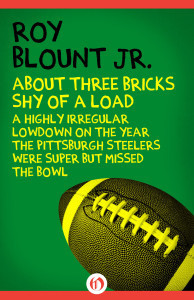 Paolantonio’s How Football Explains America), and I’m inclined to agree. Of course there’s a time lag, since Europeans arrived on this continent four centuries before the birth of American football.
Paolantonio’s How Football Explains America), and I’m inclined to agree. Of course there’s a time lag, since Europeans arrived on this continent four centuries before the birth of American football.
For historical synchronicity, let’s say the 19th-century invention of the sport parallels the arrival at Plymouth Rock; the 1920 formation of the National Football League (then known as the American Professional Football Association) was the Continental Congress; and the years leading up to and including the early Super Bowls was the Wild West. Since then, football has enjoyed the popularity and profit of post-WWII America.
The bridge between the NFL’s lawless pre-history and current glory days is the 1970s, when the organized mayhem of the sport electrified color televisions across the nation. It was the decade dominated by the Pittsburgh Steelers.
In 1973, author Roy Blount Jr., whom many will know as a regular panelist on National Public Radio’s Wait Wait… Don’t Tell Me!, spent the season with the Steelers at a crucial moment—months after the Immaculate Reception and a year before their first Super Bowl victory.
The result was the gonzo-style About Three Bricks Shy of a Load, which has been re-released in honor of the book’s fortieth anniversary.
I have a personal interest in this book: I was born in western Pennsylvania in 1972, and you bet your ass I bleed black and gold. Possessing that strain of superstition unique to sports, I don’t think it’s a coincidence that the Steelers won a grand total of 0 postseason games prior to my birth and since then have been the winningest team in football.
As a youth, I idolized the ’70s Steelers, but didn’t yet have the sophistication (or skepticism) to consider the lives of the men behind the facemasks. It was with great interest, then, that I read About Three Bricks Shy of a Load to learn more about the incubation of a dynasty. What sets this apart from similar books (such as Their Life’s Work and Steel Dynasty) is that it captures the highs and lows of the 1973 season without the sentimentality of age or the foreknowledge of future championships.
However, this isn’t a yearbook. This is an in-the-trenches account of the players and personalities that epitomized professional football of that era—a time before the NFL became PG rated. Blount’s embedded reporting is remarkable, from the openness of alcohol, drugs and sex to the lingering racial and culture divides of the 1960s. I’ve learned more about the team I idolized in this one book than I did growing up an hour from Three Rivers Stadium.
However, this is still a book of general interest. Although its emphasis is on one team, it is a pivotal bit of prehistory to the NFL’s dominance. A raw, unfiltered look at a free-wheeling sports league before it became a tight-lipped, humorless corporation.
Of course, there are shadows that loom over this narrative. Just as nobody in 1973 could have foreseen the success of the Steelers and the NFL, also unknown was the physical toll of steroids and repeated blows to the head. The significance of this book will likely increase with age, especially as the NFL finds itself at a crossroads—its popularity has never been greater, but lawsuits, science and dropping youth enrollment portent a shaky future.
History is always a work in progress, and the definitive narrative of the NFL has yet to be written. But when it is, About Three Bricks Shy of a Load will be a document of a special time in a special place, the story of a team on the cusp of greatness falling just shy of its goal.


December 28, 2013
Review: Newton’s Football
Newton’s Football: The Science Behind America’s Game
Allen St. John and Ainissa G. Ramirez
Here’s a book combining two of my favorite things: science writing and football. Turns  out they go together as naturally (and tastily) as Dorito’s and M&Ms, and like that classic combo, I binged on it until it was all gone. The authors write with passion and knowledge, and in every chapter there was something I didn’t know, either about science or the sport I love.
out they go together as naturally (and tastily) as Dorito’s and M&Ms, and like that classic combo, I binged on it until it was all gone. The authors write with passion and knowledge, and in every chapter there was something I didn’t know, either about science or the sport I love.
It begins, fittingly, with an interview with Stephen Wolfram (the theoretical physicist and author of A New Kind of Science), who explains the role chaos theory plays in your team’s game plan. I had always considered the 12th man to be the home crowd, but it turns out to be initial conditions. “Change the initial conditions and the outcomes diverge exponentially,” Wolfram says, leading the authors to extrapolate that “The no-huddle offense was chaos theory at work.”
My new dream is to hear Chris Berman reference initial conditions during a highlight reel.
The ball itself has an interesting history—and a physics all its own. There is no such thing as a tight spiral, for example, since the pigskin (which isn’t really pigskin) requires gyroscopic torque to remain in flight. Knowing that, you might just feel empathy rather than outrage the next time your quarterback lofts a lame duck over the middle.
This book transforms the gridiron into a laboratory. And much like those “Eureka” moments in the lab, serendipity and circumstance had a hand in the game’s innovation, such as the introduction of the West Coast offense and the soccer-style kick. St. John and Ainissa also prove that not all penalties are created equal: The more important stat is not penalty yardage but the breakdown between offensive and defensive infractions.
There is a serious side to Newton’s Football as well. While advances in neuroscience have revealed the extent of football’s brutality, many are wondering if football will exist in another 25 years—and if so, will it be recognizable to today’s fans. The authors explore the current concussion research and uncover some possible solutions.
Along the way, the authors revisit some of the game’s most famous plays and players, and combine physics and football with narrative journalism in one of the easiest and most interesting reads I’ve encountered all year (and that’s no small amount of books). Definitely in my top 10.
Newton’s Football is a must-have for fans of football and/or science. Not everyone is a fan of both, which is all the better because this book offers a chance to expand one’s horizons.
By the final page it will have armchair quarterbacks running statistical analysis and lab rats rubbing elbows at the sports bar. Does it get more interesting than that?


December 27, 2013
Review: Buddhist Biology
Buddhist Biology
David P. Barash
Forgive me a nostalgia trip to 1994, when alt-jazz rockers Soul Coughing released their  debut album Ruby Vroom. The lead track was “Is Chicago, Is Not Chicago,” a hypnotic, oddly existential number allegedly inspired by a bad acid trip in which singer Mike Doughty must distinguish between himself and his surroundings.
debut album Ruby Vroom. The lead track was “Is Chicago, Is Not Chicago,” a hypnotic, oddly existential number allegedly inspired by a bad acid trip in which singer Mike Doughty must distinguish between himself and his surroundings.
It made for a great song, but any biologist will tell you it doesn’t hold up to modern science. Or, for that matter, not-so-modern philosophy.
But Doughty was working toward something significant in that trippy little tune: Where does the “I” end and the “everything else” begin?
It may very well be at the intersection of science and spirituality, according to scientist and self-described Buddhist atheist David P. Barash, author of the brilliant Buddhist Biology.
He admits at the beginning that his goal is an ambitious one: to locate common ground where science and spirituality may coexist. Whereas the Abrahamic religions have long been at odds with science, he argues that Buddhist thought is compatible with high school textbooks.
“Why? Because among the key aspects of Buddhism, we find insistence that knowledge must be gained through personal experience rather than reliance on the authority of sacred texts or the teachings of avowed masters, because its orientation is empirical rather than theoretical, and because it rejects any conception of absolutes.” (18)
That is to say, it allows for the scientific method.
Barash eloquently connects the principles of anatman (not-self), anitya (impermanence) and pratityasamputpada (interdependence) to current biological knowledge. Science has shattered the duality of the actor and the environment, and in doing so has validated thousands of years of Buddhist philosophy.
I am particularly interested in anitya, which leads us into discussions regarding the illusion of time and motion. In considering life as a sequence of moments, Barash distinguishes between the experiencing self and the remembering self (which is similar to Sartre’s Pre-Reflective Cogito, but don’t get me started on my boy Jean-Paul).
The main idea is that each moment is unique and temporary. Nothing lasts, except for in memory, through which we develop a narrative and impose continuity.
Now, I’ll leave the scientific explanations to Barash, as I’m not very qualified to give a proper breakdown, and only slightly more so to discuss eastern philosophy. What I am qualified to provide, though , is a recommendation of Buddhist Biology. Barash takes difficult concepts and presents them in a thoroughly readable and enjoyable narrative. You’ll learn new things, brush up on your philosophy and find it difficult to close this book.
You’ll come away with the realization that there is no distinction between Chicago and Not Chicago, Is and Is Not. There is only this moment.
Or more simply put, There Is.


December 23, 2013
Last-Minute Literature
The tick-tock of the holiday shopping season is winding down (or perhaps gearing up with desperation). If you’re still needing a last-minute book for the literati in your life, these blurbs should help differentiate the Red Ryder BB gun from the lumps of coal.
Diary of Edward the Hamster (1990-1990)
Miriam and Ezra Elia
I didn’t think anyone anthropomorphized animals more than me until I read this diary,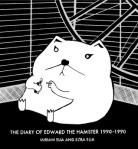 translated from the notes left behind by Edward the Hamster. Much like the Marquis de Sade, who wrote extensively while in prison and only achieved literary fame posthumously, this artifact of Edward’s incarceration is certain to elicit pathos in readers.
translated from the notes left behind by Edward the Hamster. Much like the Marquis de Sade, who wrote extensively while in prison and only achieved literary fame posthumously, this artifact of Edward’s incarceration is certain to elicit pathos in readers.
It’s clear that Edward has studied the likes of Heidegger and Sartre. His reflections are wrought with defiance, despair and existential angst. He searches for meaning within his cage. There is food, water, a wheel.
“Is there nothing else!” he cries.
Filled with wit and wisdom, this graphic novel is a black comic tribute to a beloved hamster—the most existential beast within the animal kingdom. The drawings are cute, the entries are funny, but sprinkled throughout the book are philosophical nuggets like, “Why write? Life is a cage of empty words,” and “Is this cage of my own making?”
Along the way, we follow Edward through failed escapes, domestic discord and bliss and a final, bloody insurrection. This is a quick and playful read, with clever artwork, and will bring a smile to the philosopher in your life.
The Never List
Koethi Zan
There is a bitter synchronicity to Koethi Zan’s debut novel, The Never List. Concerning 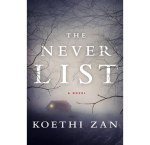 the lives of three women held captive in a madman’s basement, The Never List hit shelves 10 days before Ariel Castro pled guilty to holding three women hostage in his Cleveland basement.
the lives of three women held captive in a madman’s basement, The Never List hit shelves 10 days before Ariel Castro pled guilty to holding three women hostage in his Cleveland basement.
I’m reminded of the Alice Cooper tale of his first trip to England. According to legend, a woman died during the flight, and it fueled his notoriety when he emerged on UK soil trailing a cadaver. Serendipity may not be the polite word, but by dictionary definition…
So, I read this book in July and loved it. The writing is solid and the narrative compelling, and I intended to review it at that time. Unfortunately, it got lost in the barrage of new releases.
There is a news hook, though, as the book is being adapted for television, and will be written by transgressive author A.M. Homes, which should make for wonderfully disturbing television.
The First Thanksgiving
Nathaniel Philbrick
This short work, a reworking of a chapter from Philbrick’s Mayflower: A Story of 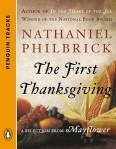 Courage, Community, and War, is a great introduction to anyone interested in historical nonfiction who may be daunted by Philbrick’s longer works. There aren’t enough superlatives for Philbrick’s writing, and this appetizer will make any reader want to read the Mayflower, or any of his works, in full.
Courage, Community, and War, is a great introduction to anyone interested in historical nonfiction who may be daunted by Philbrick’s longer works. There aren’t enough superlatives for Philbrick’s writing, and this appetizer will make any reader want to read the Mayflower, or any of his works, in full.
It’s the history of a holiday that we still celebrate, yet holds little connection to its origin. Here, we get the story we never learned in elementary school—such as the high mortality rates of the Pilgrims. Thanksgiving is now a spectacle of consumption and consumerism. Yet of the roughly 150 passengers and crew aboard the Mayflower, only half survived that first winter. Suffice to say, reading about the hardships of the settlers at the time of the first Thanksgiving will shame anyone who dares complain about Black Friday checkout lines.
God is Disappointed in You
By Mark Russell and Shannon Wheeler
Some jokes never get old, as evidenced in this irreverent abridging of The Bible. The  humor is sharp, varying from silly to satirical, and the illustrations add to the humor. While it is funny, there is also an earnestness within the narrative, as Russell attempts to condense the entire text to its core concepts.
humor is sharp, varying from silly to satirical, and the illustrations add to the humor. While it is funny, there is also an earnestness within the narrative, as Russell attempts to condense the entire text to its core concepts.
Ambitious idea, and one not to be taken too seriously, but I dispute the author’s claims of accuracy. For example, which version of The Bible? If biblical scholars have been unable to agree on the official canon, I won’t expect it to be decoded in a humor book.
But taken for what it is, God is Disappointed in You is good, clean fun, filled with soul-lightening humor. If the publisher is smart, they’re already compiling a 365-frame calendar version to market over the holidays.
If so, sign me up.
Doomed
Chuck Palahniuk
Chuck, we love you. Please remember that. Lullaby is one of the most amazing books I’ve ever read, and I even found a way to work it into my master’s thesis. Choke is cutting social satire of the first order, Fight Club one of the greatest films ever made. Survivor is brilliant in plot, character and execution, and don’t get me started on the thrill-ride that is Haunted.
I’ve ever read, and I even found a way to work it into my master’s thesis. Choke is cutting social satire of the first order, Fight Club one of the greatest films ever made. Survivor is brilliant in plot, character and execution, and don’t get me started on the thrill-ride that is Haunted.
But I do have a few pet peeves that pop up in Doomed, the sequel to Damned.
First, I don’t have much patience for fiction written in the voice of a child. No matter the skill of the writer, an adult giving voice to a child always comes across as inauthentic and, in the worst cases, foolish. Also, exactly what are we to learn from a child narrator? It certainly won’t shock or disturb any hardened reader of horror or transgressive fiction.
Second, humor in horror is an iffy proposition. When it works, it’s organic, or the comedy is more disturbing than the tragedy (for example, many of the stories in Haunted). Better incidental humor than intentional. Doomed reads more like a Christopher Moore novel (albeit an extremely dark and cynical one).
I’m a fan of Moore’s, but his brand of humor is expected. When I read Palahniuk, I look forward to that nausea that lingers and ultimately consumes me, which I’ve found absent in Doomed.


December 14, 2013
Review: Best American
The Best American series has designed such a unique identity that I can recognize a volume through the thickest wrapping paper. The symmetry of the books is soothing, 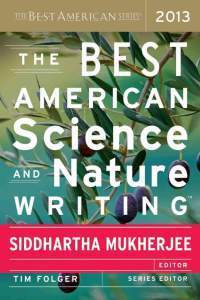 and they look dynamite aligned on the shelves. A friend recently stared in awe of their arrangement on my bookcase (thanks OCD).
and they look dynamite aligned on the shelves. A friend recently stared in awe of their arrangement on my bookcase (thanks OCD).
But it’s the content that really makes Best American stand out.
My three favorite editions are the science, essay and mystery writing editions, with lots of love for the sports, short stories and nonrequired reading, but that’s part of what makes the series so successful: everybody has a favorite, but is usually willing to take a gander at the others.
So when I see a Best American beneath the tree, I’m not worried about which one it is. I know I’ll enjoy it no matter what.
Here is a sampling of what you’ll find in this year’s editions:
For me, the 2013 headliner is The Best American Science and Nature Writing, edited by Siddhartha Mukherjee (The Emperor of All Maladies). Standouts include Kevin Dutton’s “What Psychopaths Teach Us About How to Succeed,” adapted 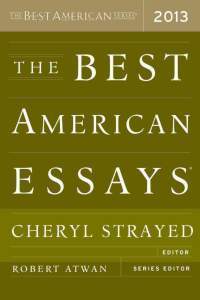 from his book, The Wisdom of Psychopaths, as well as Oliver Sacks’ “Altered States,” and Gareth Cook’s “Autism Inc.”
from his book, The Wisdom of Psychopaths, as well as Oliver Sacks’ “Altered States,” and Gareth Cook’s “Autism Inc.”
The Best American Sports Writing is edited by J.R. Moehringer, whose magazine feature, “Resurrecting the Champ,” inspired a wonderful fictionalization on the big screen. Must-reads include Rick Reilly’s “Special Team,” Paul Solotaroff’s “The NFL’s Secret Drug Problem,” and Erik Malinowski’s “The Making of ‘Homer at the Bat,’ the Episode that Conquered Prime Time 20 Years Ago Tonight.” For top-shelf nonfiction, look no further than The Best American Essays, featuring Zadie Smith, Michelle Mirsky and Alice Munro.
Joyce Carol Oates, Michael Connolly and Hannah Tinti headline The Best American Mystery Stories, while Junot Diaz, George Saunders and Steven Millhauser take the spotlight in The Best American Short Stories. Elizabeth Gilbert guest edits The Best American Travel Writing.
Once again, The Best American Nonrequired Reading slays us with its 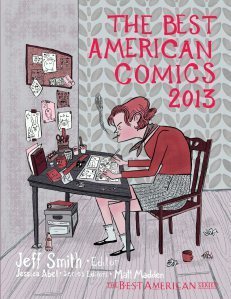 combination of literati and irreverence. Case in point: there are pieces by Walter Mosley, Sherman Alexie and Kurt Vonnegut, while the “best of” categories include “Best American Poem About a Particle Accelerator,” “Best American Apocryphal Discussion Between Our Nation’s Founding Fathers” and “Best American Comic That Ends in Arson.”
combination of literati and irreverence. Case in point: there are pieces by Walter Mosley, Sherman Alexie and Kurt Vonnegut, while the “best of” categories include “Best American Poem About a Particle Accelerator,” “Best American Apocryphal Discussion Between Our Nation’s Founding Fathers” and “Best American Comic That Ends in Arson.”
Speaking of comics, one of my favorite new editions is The Best American Comics, featuring fiction and nonfiction art work, from the “funny pages” to graphic novels. There’s now even The Best American Infographics. With an introduction by David Byrne. Go figure.





